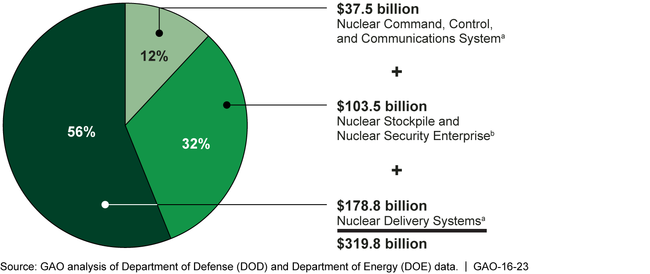Nuclear Weapons Sustainment: Improvements Made to Budget Estimates Report, but Opportunities Remain to Further Enhance Transparency
Highlights
What GAO Found
The fiscal year 2016 joint report, submitted to Congress by the Department of Defense (DOD) and the Department of Energy (DOE) in April 2015, includes 10-year budget estimates for sustaining and modernizing U.S. nuclear weapons. These estimates are generally consistent with the departments' internal funding and modernization plans—with some exceptions. GAO could not fully verify that DOD's command and control estimates were consistent with its internal funding plans, because DOD did not document the methodological assumptions and limitations associated with these estimates, as GAO had recommended in June 2014.
Departments of Defense (DOD) and Energy (DOE) Fiscal Year 2016 10-Year Estimates for Sustaining and Modernizing the U.S. Nuclear Deterrent

Note: DOD inadvertently reported an incorrect figure in its estimate for Nuclear Delivery Systems and the figure above reflects corrected data.
aDOD provides budget estimates for the nuclear command, control, and communications system, which includes early warning radars, aircraft, and communications networks, and for delivery systems, which consist of a variety of platforms such as heavy bombers, air-launched cruise missiles, and ballistic-missile submarines.
bDOE provides budget estimates for the nuclear weapons stockpile (seven types of weapons), and the nuclear security enterprise (eight geographically dispersed sites).
The fiscal year 2016 report includes information that was not included in the fiscal year 2015 report—such as general descriptions of the methodologies used to develop the budget estimates—but does not include thorough documentation of the methodologies used or comparative information about changes in the estimates that could improve transparency. Further, DOD did not ensure the accuracy of the estimates it reported, inadvertently over stating the 10-year estimate for the Air Force's long-range strike bomber. As GAO reported in July 2015, without thorough documentation of the methodologies used and comparative information on changes from year to year, it may be difficult for Congress to understand the basis for the estimates or assess long-term affordability when allocating resources. DOD partially agreed and DOE agreed with GAO's July 2015 recommendations to develop thorough documentation, but DOD noted that information on changes is not required by Section 1043.
Why GAO Did This Study
DOD and DOE are undertaking extensive efforts to sustain and modernize aging U.S. nuclear weapons capabilities, which are expected to take decades and cost hundreds of billions of dollars. Section 1043 of the National Defense Authorization Act for Fiscal Year 2012, as amended, requires submission of an annual report to congressional committees on DOD's and DOE's plans for related matters and includes a provision that GAO review aspects of that report. In its reviews of the fiscal years 2014 and 2015 joint reports, GAO recommended that future joint reports provide more thorough documentation of the methodologies used to develop the estimates and comparative information on changes in the estimates from the prior year.
GAO assessed the extent to which the fiscal year 2016 joint report provides (1) budget estimates that are consistent with the departments' internal funding and modernization plans and (2) complete, transparent information on the methodologies used to develop those estimates. GAO analyzed the departments' internal plans and budget estimates and interviewed DOD and DOE officials.
Recommendations
GAO believes its recommendations to provide more thorough documentation of methodologies and comparative information on changes in estimates from the prior year have merit and is not making new recommendations in this report. DOD and DOE said they are working to include additional information in subsequent joint reports based on GAO's prior recommendations.
